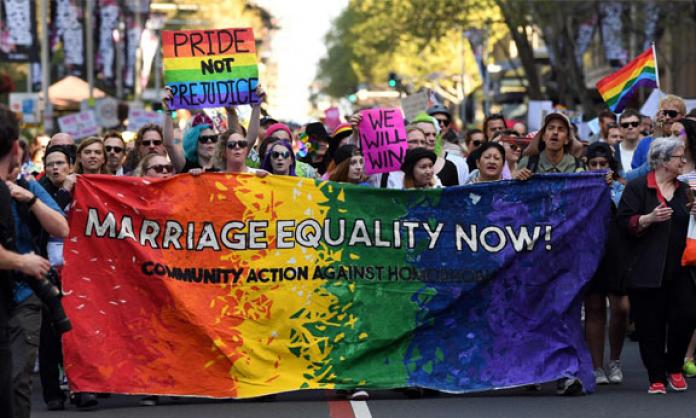“Welcome to the right side of history!” bellowed Tim Blackman, just one of the many impassioned speakers at the historic rally for marriage equality on 10 September in Sydney. The declaration was met with deafening applause and cheers from the 50,000-strong crowd, the largest protest for LGBTI rights ever held in this country.
When dozens of volunteers arrived at 11am to help the organisers set up the stage, it was obvious something big was coming. As hundreds of people congregated in the square more than an hour before the march was set to begin, we knew something special was about to happen. But it was only when Town Hall Square was overflowing with people well before the official start time that it was obvious we were part of something that would be talked about for years to come.
Attendees hung off lamp posts and fences, balanced precariously on ledges, raised their flags and placards from every possible vantage point. Union flags were prominent, but many others took the time to put their own creative spin on the day. A young boy sat on his dad’s shoulders, clearly overwhelmed and excited by the chaos. He wasn’t the only one.
Protests around this issue are known for being young and dynamic. This demo had all of that in spades, featuring thousands of high schoolers dressed in rainbow dresses, scarves, jumpers and shoelaces. Rainbow face paint and glitter covered everything and everyone; many wore rainbow halos in a cheeky nod to Lyle Shelton and the right wing Christian Lobby.
Yet the rally was significant because thousands of others came too, people who hadn’t been to a rally previously, or perhaps not since the rallies against the 2014 budget, WorkChoices or the Iraq war: the kind of decent working class people who maybe don’t come to as many protests as they should, but make history when they do.
One message received from someone’s mother explained that there were hundreds of people trying unsuccessfully to get on trains at suburban platforms. Others reported that it was nearly impossible to exit Town Hall station due to the flood of people arriving for the rally. The station was eventually closed for the duration of the event.
Rally goers were packed in like sardines, yet the police failed to carry out the basic task of redirecting foot traffic away from the event. This only backfired as passers-by spontaneously joined the festivities, adding their enthusiasm to the already triumphant mood.
You can’t overstate the importance of events like these.
The bigots have been doing all they can to deflect the debate away from marriage equality and on to other issues – child abuse, Safe Schools and political correctness. These arguments have gained press coverage that far exceeds their broader social appeal, and champions of the No campaign have rarely been challenged on their archaic and homophobic views.
Now they have.
The numbers attending demonstrations around the country do not lie. Fifty thousand in Sydney, 10,000 in Brisbane, 4,000 in Canberra, 20,000 in Melbourne, and thousands more participating in rallies organised in regional centres across the country. This is not a debate; this is a civil rights movement – a civil rights movement that is winning.
There has been much talk of the trauma caused by the plebiscite, but it is undeniable that these mass marches leave people feeling uplifted and empowered. The grinding oppression of daily life is pushed back, replaced with elation and a determination to fight and win.
Another reason to march is that we know that the homophobes cringe when they see such immense solidarity and the kind of power that comes only from collective action. The contrast to their No campaign is clearest at these moments. The miserable protests called in defence of “traditional marriage” have failed to attract more than a tiny crew of fascists and Christian fundamentalists.
But the battle for equality is not over.
The No campaigners will continue to receive massive air time and column inches to spread their hate, and will undoubtedly keep pushing to mobilise the most reactionary sections of the population to stifle progress toward equality in whatever ways they can. Even if they lose, they will try to undermine our victory by placing exemptions that allow institutions to maintain discriminatory practices.
There are so many things that can be done to give our side the strength we need to win.
Selling badges at work or at school is an easy and proven conversation starter, as is placing a poster or leaflet in support of the Yes campaign on a notice board or kitchen counter. You could even organise a day to bring ballots and collectively deposit them, or just take a solidarity photo with a group of friends and post it online. Everything helps.
But the big demonstrations prove that the best way to destroy the bigots’ schemes is to mobilise in our thousands, demanding equality with no conditions. We’re about to make history. Let’s make it good for once.









